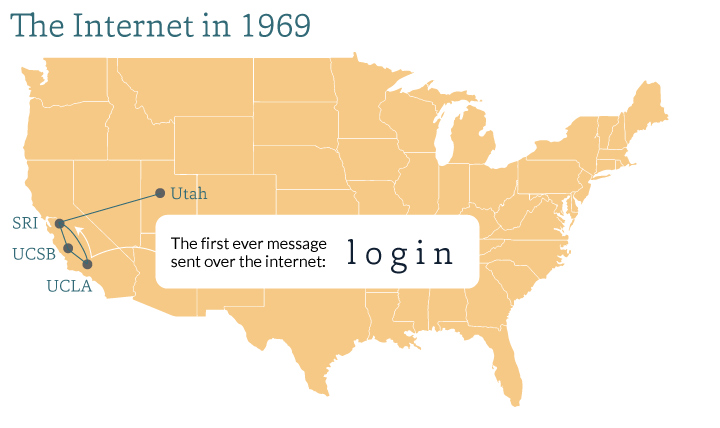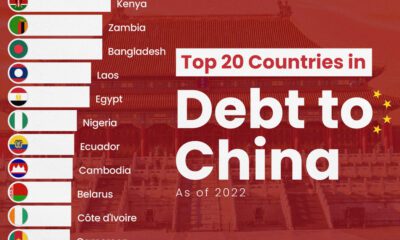Technology
A Look Back at Internet Firsts
In October 1969, UCLA student Charley Kline was attempting to send the word “login” over to the Stanford Research Institute using the internet’s precursor: ARPANET.
At first, the system crashed, only managing to send the letters “i” and “o”. But an hour or so later, the full message was successfully sent and history was made:

Today, the internet permeates every facet of modern life. Billions of people around the world communicate through messaging apps, email, and social media platforms. By 2020, an estimated 20.8 billion “things” will be connected to the internet (including 13 billion household items like TVs, smoke detectors, and appliances).
It all starts somewhere
Though YouTube, Facebook, and email are ubiquitous now, they all started out with a single post, profile, or message, and that first action is not always what you’d expect.
As today’s infographic from Academized demonstrates, “firsts” on the internet are typically unpolished, unique snapshots of the people involved in creating the platform. From elephants at the zoo to live-streaming a coffee pot, we hope you enjoy this trip down memory lane.

Links to Notable Internet Firsts
Everything posted to the web now lives in perpetuity.
Here are some notable internet firsts that can still be viewed, replicated, or experienced:
The First Search Engine
The first search engine was created to connect the McGill University’s School of Computer Science to the Internet. The engine, called Archie, was up-and-running in 1990, a full eight years before Google was created. The University of Warsaw still hosts a functioning version of Archie for historical purposes.
The First Amazon Order
Today, Amazon processes billions of orders per year, but the very first order was placed in July 1995. The grandiosely named book, Fluid Concepts and Creative Analogies: Computer Models Of The Fundamental Mechanisms Of Thought, was ordered by computer scientist John Wainwright, who was beta-testing Amazon.com.
The First YouTube Video
The very first YouTube video was uploaded by YouTube’s co-founder, Jawad Karim. The 19-second video is no Gangnam Style. Jawad, who is standing in front of an elephant enclosure, deadpans, “Uh. The cool thing about these guys is that, is that they have really, really, really long, um, trunks, and that’s, that’s cool.” Cool, indeed.
The First Tweet
just setting up my twttr
— jack (@jack) March 21, 2006
Internet firsts are rarely flashy, as this tweet from Twitter co-founder, Jack Dorsey, demonstrates. That said, as startups grow from rag-tag teams of determined founders into global behemoths, it’s nice to look back at those authentic, spontaneous first pieces of content.
Technology
All of the Grants Given by the U.S. CHIPS Act
Intel, TSMC, and more have received billions in subsidies from the U.S. CHIPS Act in 2024.

All of the Grants Given by the U.S. CHIPS Act
This was originally posted on our Voronoi app. Download the app for free on iOS or Android and discover incredible data-driven charts from a variety of trusted sources.
This visualization shows which companies are receiving grants from the U.S. CHIPS Act, as of April 25, 2024. The CHIPS Act is a federal statute signed into law by President Joe Biden that authorizes $280 billion in new funding to boost domestic research and manufacturing of semiconductors.
The grant amounts visualized in this graphic are intended to accelerate the production of semiconductor fabrication plants (fabs) across the United States.
Data and Company Highlights
The figures we used to create this graphic were collected from a variety of public news sources. The Semiconductor Industry Association (SIA) also maintains a tracker for CHIPS Act recipients, though at the time of writing it does not have the latest details for Micron.
| Company | Federal Grant Amount | Anticipated Investment From Company |
|---|---|---|
| 🇺🇸 Intel | $8,500,000,000 | $100,000,000,000 |
| 🇹🇼 TSMC | $6,600,000,000 | $65,000,000,000 |
| 🇰🇷 Samsung | $6,400,000,000 | $45,000,000,000 |
| 🇺🇸 Micron | $6,100,000,000 | $50,000,000,000 |
| 🇺🇸 GlobalFoundries | $1,500,000,000 | $12,000,000,000 |
| 🇺🇸 Microchip | $162,000,000 | N/A |
| 🇬🇧 BAE Systems | $35,000,000 | N/A |
BAE Systems was not included in the graphic due to size limitations
Intel’s Massive Plans
Intel is receiving the largest share of the pie, with $8.5 billion in grants (plus an additional $11 billion in government loans). This grant accounts for 22% of the CHIPS Act’s total subsidies for chip production.
From Intel’s side, the company is expected to invest $100 billion to construct new fabs in Arizona and Ohio, while modernizing and/or expanding existing fabs in Oregon and New Mexico. Intel could also claim another $25 billion in credits through the U.S. Treasury Department’s Investment Tax Credit.
TSMC Expands its U.S. Presence
TSMC, the world’s largest semiconductor foundry company, is receiving a hefty $6.6 billion to construct a new chip plant with three fabs in Arizona. The Taiwanese chipmaker is expected to invest $65 billion into the project.
The plant’s first fab will be up and running in the first half of 2025, leveraging 4 nm (nanometer) technology. According to TrendForce, the other fabs will produce chips on more advanced 3 nm and 2 nm processes.
The Latest Grant Goes to Micron
Micron, the only U.S.-based manufacturer of memory chips, is set to receive $6.1 billion in grants to support its plans of investing $50 billion through 2030. This investment will be used to construct new fabs in Idaho and New York.
-

 Economy7 days ago
Economy7 days agoRanked: The Top 20 Countries in Debt to China
-

 Demographics2 weeks ago
Demographics2 weeks agoThe Countries That Have Become Sadder Since 2010
-

 Money2 weeks ago
Money2 weeks agoCharted: Who Has Savings in This Economy?
-

 Technology2 weeks ago
Technology2 weeks agoVisualizing AI Patents by Country
-

 Economy2 weeks ago
Economy2 weeks agoEconomic Growth Forecasts for G7 and BRICS Countries in 2024
-

 Wealth2 weeks ago
Wealth2 weeks agoCharted: Which City Has the Most Billionaires in 2024?
-

 Technology1 week ago
Technology1 week agoAll of the Grants Given by the U.S. CHIPS Act
-

 Green1 week ago
Green1 week agoThe Carbon Footprint of Major Travel Methods











